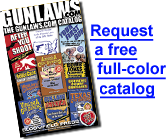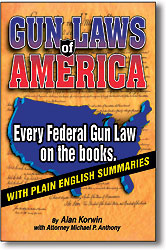
| Home | Books | National Directory | Position Papers | Alan’s Blog | FAQ | New Stuff | Search |
UPDATES TO FEDERAL GUN LAW
FROM Oct. 2000 to Dec. 31, 2002
|
|
||
Gun Laws of America Update for 2003 (Not included in Edition 4):
The Undetectable Firearms Act
Arming Cargo Pilots Against Terrorism
"UPDATE 5" This update covers changes included in Edition 4 of Gun Laws Of America, released
in February 2003. Federal gun law has grown 6.5% since Oct. 2000, to a new total of 94,333 words.
Summary of changes in the
NOTES ON BOOK PUBLISHING STATUS (June 6, 2002): SMITH & WESSON PREFERENCE BAN THE USA PATRIOT ACT ARM THE PILOTS HOMELAND SECURITY ACT OF 2002 From: Public Law 106-398
THE ACTUAL STATUTES
HOMELAND SECURITY ACT From: Public Law 107-296 by Alan Korwin with Attorney Michael P. Anthony It's like having a complete gun-law library in one volume. Don't be fooled by BATF's partial set. This is the first time that every federal gun law has been collected and printed. Laws about the proper authorities, the Militia, National Guard, citizens, collectors, dealers, manufacturers, importers, global disarmament, free training ammo, your rights, the governments limits, the Lost National Right to Carry; many of the laws protect people or regulate the government but are virtually unknown. If you knew all your rights you might demand them! Good laws, bad laws, 70 pages of juicy intro material, and the plain-English summaries make everything so easy. It's actually fun to read -- you'll refer to it again and again. You owe it to yourself to keep a copy of the laws handy... settles arguments big time. Broadly endorsed by legal experts. "Outstanding," -former Arizona Attorney General Bob Corbin. "Unique," -Constitutional scholar and attorney Stephen P. Halbrook, Ph.D. Makes a better gift than a tie. Copyright © 2003 Alan Korwin All rights reserved No part of the original content of this publication may be reproduced or transmitted in any form or by any means now known or which will become known, without written permission from the publisher. Permission is granted for reviewers and others to reprint portions of this update for use in newspapers, periodicals, broadcasts or digicasts on two conditions: 1)Send a copy of your published version to Bloomfield Press at the address below; and 2)Include the following message: This update on the federal gun laws is provided by Bloomfield Press, publishers of Gun Laws of America --Every Federal Gun Law on the Books, with Plain-English Summaries. For information call 1-800-707-4020. Bloomfield Press invites you to send an old-fashioned stamped, self-addressed
envelope for information about future updates. ATTENTION: Clubs, Organizations, Firearms Training Instructors, Educators, Retailers, FFLs, Bookstores and all interested parties: Contact the publisher for information on quantity discounts! Every gun owner needs this book. It doesn't make sense to own a gun and not know the rules. |
||
 on gun laws and other topics.
|


